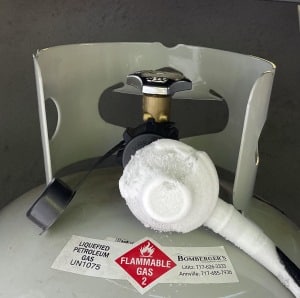Can LPG Freeze – LPG Freezing Point – Why Do LPG Bottles Freeze
LPG (propane) freezing point is -188 °C (-306.4°F).
This would only ever occur under laboratory conditions.
There is no place on the planet where temperatures this low occur in nature.
LPG does not freeze in winter.
LPG (propane) boils at -42°C (-43.6°F), which means that the liquid propane does not vaporise – turn to gas – below that temperature.
So, unless you live in Antarctica, you should have no problem.
So, yes, technically LPG can freeze but it never freezes outside of a laboratory situation.
Then how does frost or ice appear on gas bottles, regulators and fittings?
Too Cold to Work
 As noted previously, LPG gas does not freeze in any non-laboratory situation, as the LPG (propane) freezing point is at -306.4°F (-188 °C).
As noted previously, LPG gas does not freeze in any non-laboratory situation, as the LPG (propane) freezing point is at -306.4°F (-188 °C).
So, you might be able to get it to the freezing point in a laboratory, but not in real life.
However, what many really want to know is if the gas bottle ever gets too cold to work.
The average winter temperature at the South Pole is about -56.2°F (-49°C).
So, if you live in Antarctica, your LPG (propane) could stop functioning if the temperature dropped below -43.6°F (-42°C), the boiling point of LPG (propane).
The boiling point is the temperature at which vaporisation begins and the liquid LPG (propane) turns to gas.
For the rest of us, the propane will keep working.
However, if you have a smallish gas bottle, really cold weather and high demand, your gas bottle might struggle to keep up.
If you live in a snowy climate, it’s a good idea to keep the snow from accumulating on top of exposed propane tanks, so that the sun can help warm them.
As you can see from this vaporisation table, the gas output, measured in MJ/hr, drops off as the temperature drops.
| Maximum vapourisation rates at different ambient temperatures | ||||||
| Size | -18°C | -7°C | -1°C | 4°C | 10°C | 16°C |
| 45kg | 47MJ/hr | 70MJ/hr | 84MJ/hr | 90MJ/hr | 101MJ/hr | 113MJ/hr |
Does Butane Freeze?
Does butane keep working in cold weather?
NO, not very well. Butane stops vaporising – turning to gas – at -0.4°C (31.3°F).
However, with the very low LPG-Butane freezing point of -140°C (-220°F), liquid butane would also not freeze outside of a laboratory environment.
So, it would not be rare to have no butane gas in a winter climate that doesn’t even come close to Antarctic low temperatures.
It just needs to be below freezing.
That’s why propane is preferred in colder climates, as it keeps working… with the possible exception of the South Pole!
How Does Ice Form on Gas Bottles and Regulators
 To form gas bottle frost or ice on the outside of a gas bottle, the surface temperature of the gas bottle only needs to drop below 32°F (0°C).
To form gas bottle frost or ice on the outside of a gas bottle, the surface temperature of the gas bottle only needs to drop below 32°F (0°C).
The liquid propane itself does not have to reach the LPG freezing point, which occurs at -306.4°F (-188 °C).
The liquid propane inside the propane tank can remain a liquid, without freezing, even whilst chilling the gas bottle itself to well below 32°F (0°C).
The gas bottle gets colder when you are actually using the gas, resulting in condensation, frost or ice forming on the gas bottle, when sufficient humidity is present.
Initially, condensation forms when the temperature of the gas bottle drops below the dew point.
This is exactly the same as the condensation you get on a humid day with a glass of ice water.
As the temperature continues to drop, the condensation may turn to frost or ice.
Why Does the LPG Gas Bottle Get So Cold?
A gas bottle get cold in the first place as the result of a process called vaporisation, during which liquid propane turns to gas.
This happens at the very low temperature of -43.6°F (-42°C), but well above the liquid propane-LPG freezing point of -306.4°F (-188 °C).
Propane (LPG) is stored under pressure, as a liquid, in a propane tank and is also referred to as natural gas liquids – NGL.
It turns back into a gas by ‘boiling’ into gas vapour.
 To boil, the liquid propane draws heat from the steel walls of the gas bottle.
To boil, the liquid propane draws heat from the steel walls of the gas bottle.
This, in turn, makes the gas bottle feel colder than the ambient temperature.
The gas bottle gets even colder when you are actually using the gas.
With sufficient humidity and when you are using gas rapidly, condensation or ice can form on the gas bottle.
The visible condensation or frost line indicates the level of the liquid gas remaining in the gas bottle.
The picture shows this on a small dark coloured gas bottle, so it is easier to see.
Gas Regulator Freezing

As the gas passes through the gas regulator, it expands, resulting in very cold gas vapour temperatures and external gas regulator freezing.
This is caused by extremely cold temperatures and will see the gas regulator freezing, with sufficient humidity, ice will form on the outside of the gas regulator.
This is why, under normal operation in warm and humid climates, the outside of a gas regulator will feel cold to the touch and may also be wet, frosted or frozen, with the gas regulator freezing.
Final Thoughts
People ask “Can and does LPG freeze?” but it probably isn’t really the question that most people want answered.
The literal answer is that it can freeze but that it would never happen in normal use.
What they typically want to know is if the ice that forms on the outside of gas bottle and the gas regulator freezing will stop the gas flow.
The formation of frost and ice can and does happen without impeding the flow of gas and without the liquid propane (LPG) freezing.
However, the formation of frost or ice is indicative of a vessel being too small to meet the vaporisation requirements of the system.
The use of a larger vessel and/or a vaporiser may be indicated.
New Residential LPG customer?
New Business LPG customer?
Existing ELGAS customer?
Steve Reynolds
Technical Consultant
Steve Reynolds is a leading expert in the LPG industry with over 22 years of experience. As part of the national management team at ELGAS, Steve ensures the safe and efficient storage, handling, and transportation of LPG. He serves as the lead investigator for incidents and collaborates with authorities on industry developments.
Steve is a technical advisor to Standards Australia and Gas Energy Australia (GEA), and an active member of the World LPG Association (WLPGA), contributing to global standards and technical reviews. He holds a BSc. (Hons) in Industrial Chemistry from UNSW and has held senior safety and technical roles at ELGAS, making him a trusted authority in LPG safety and standards.
